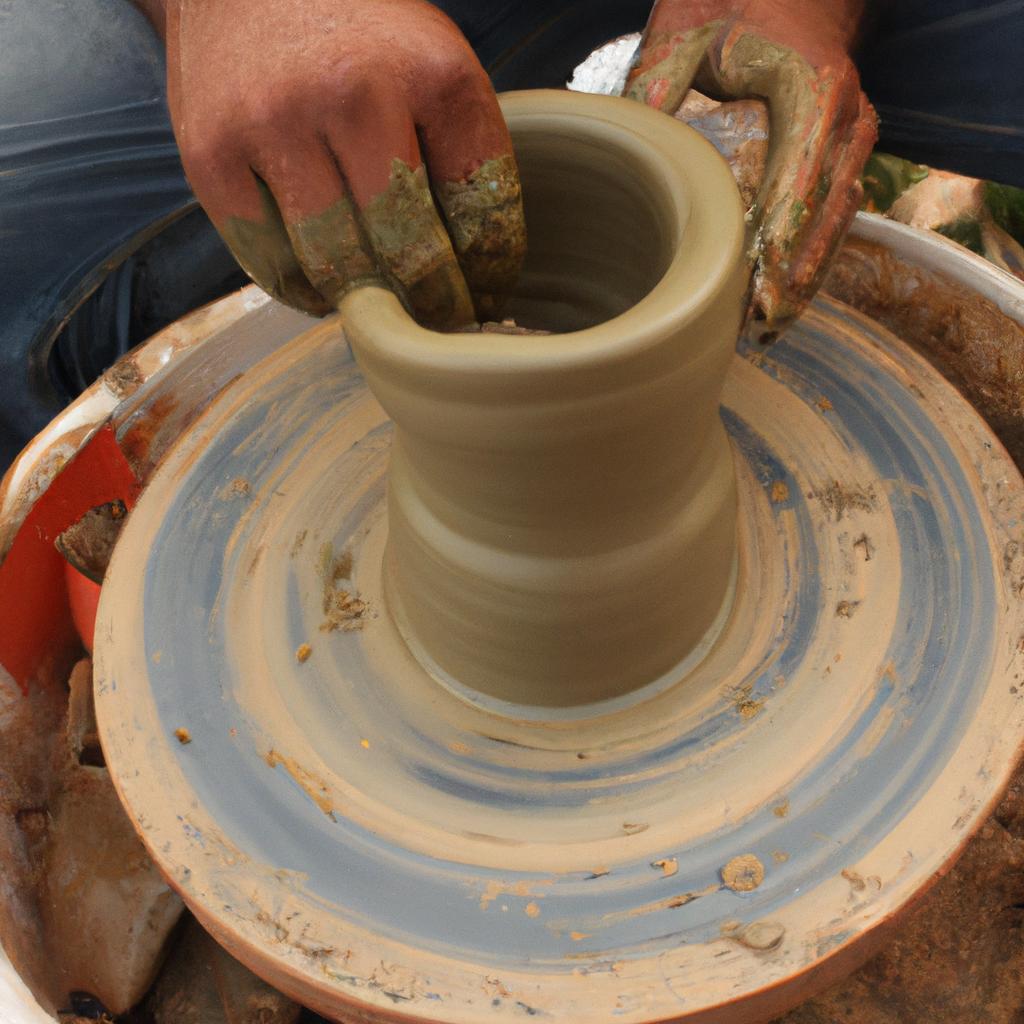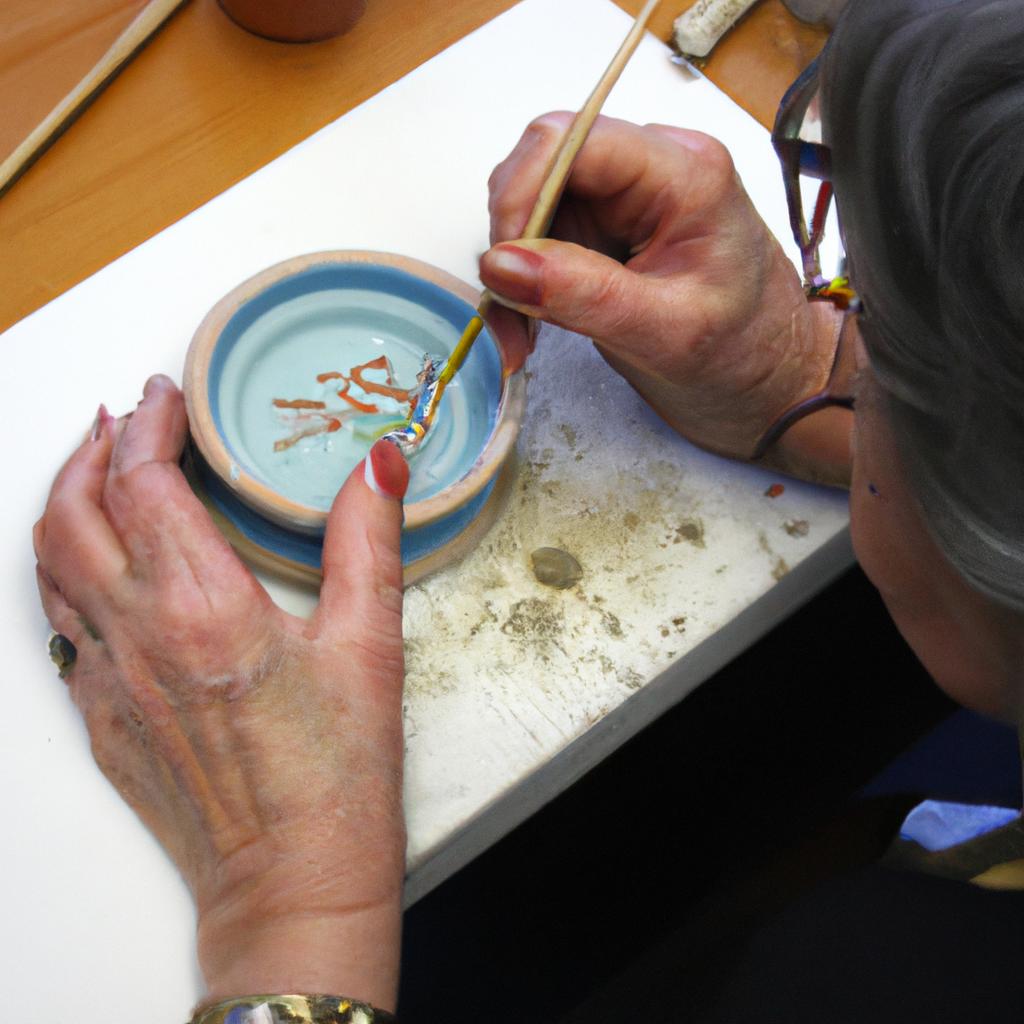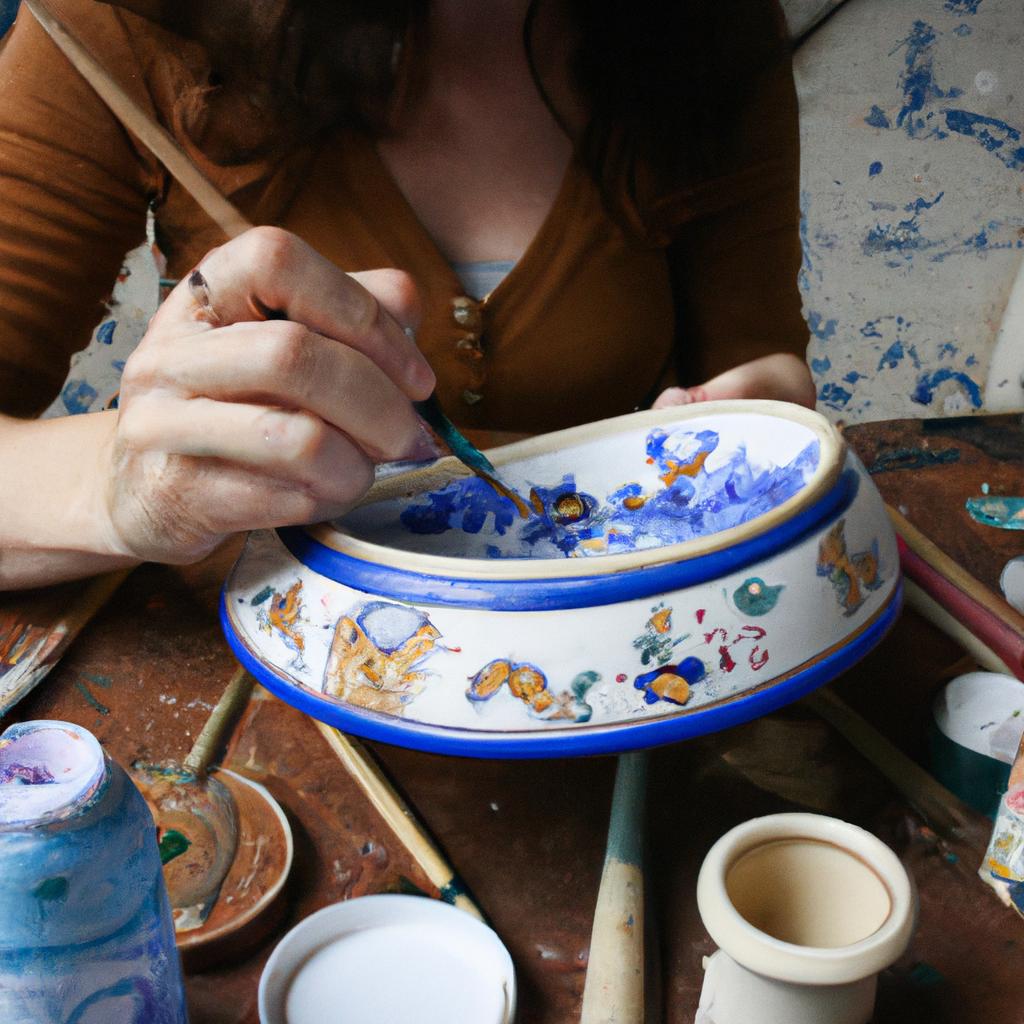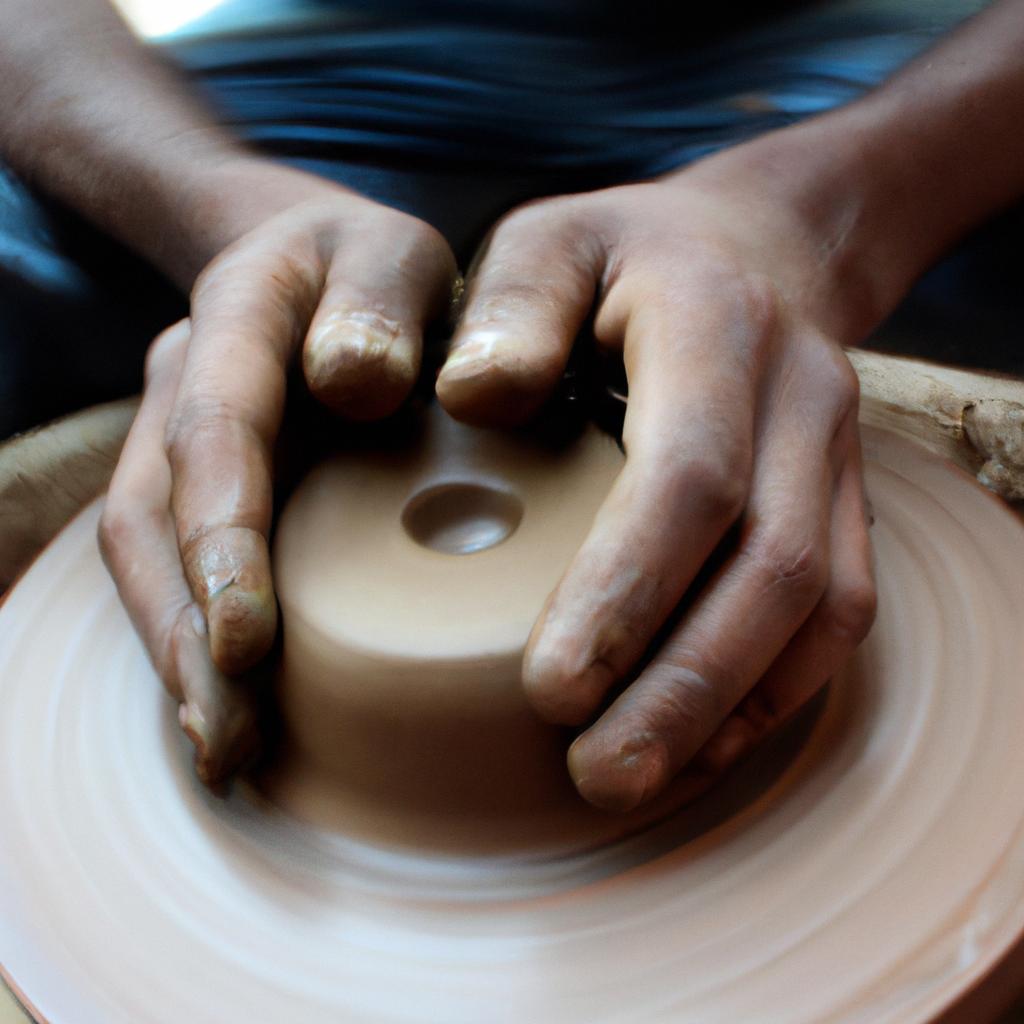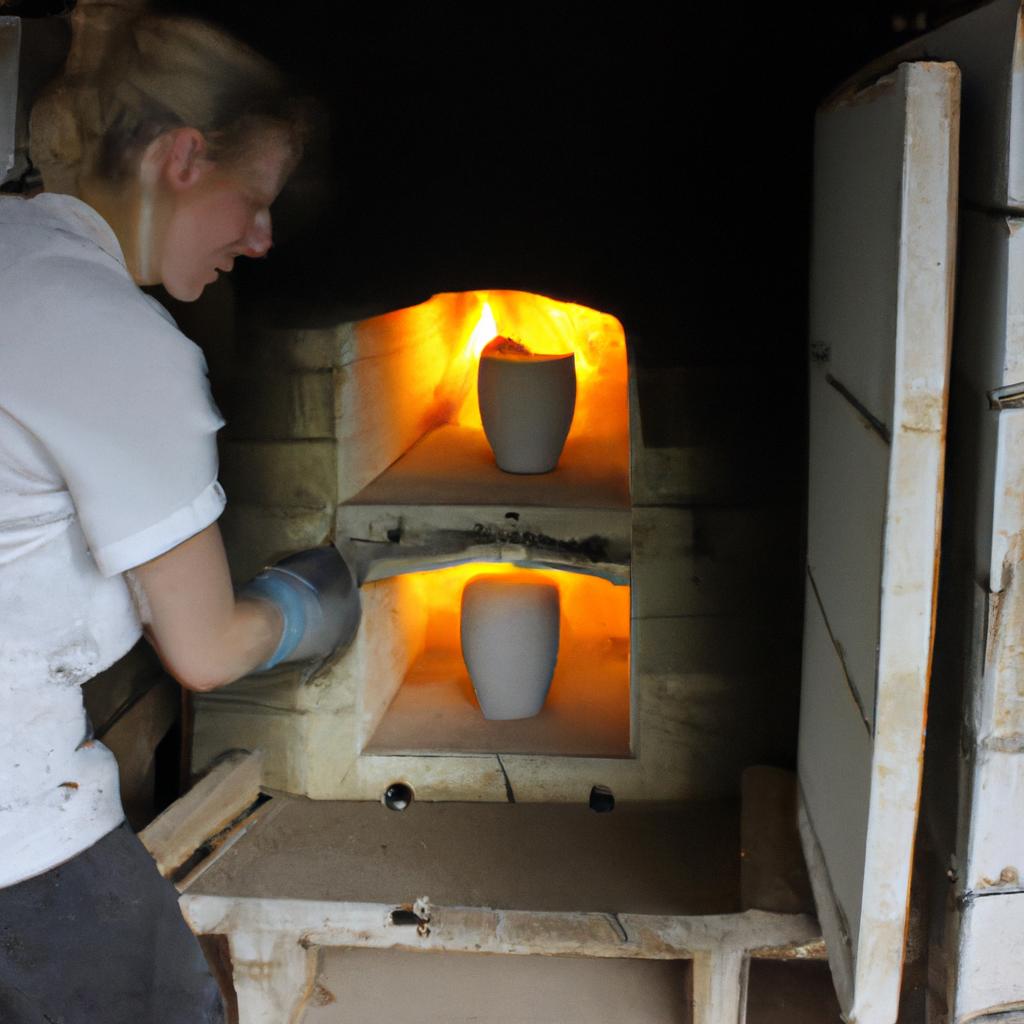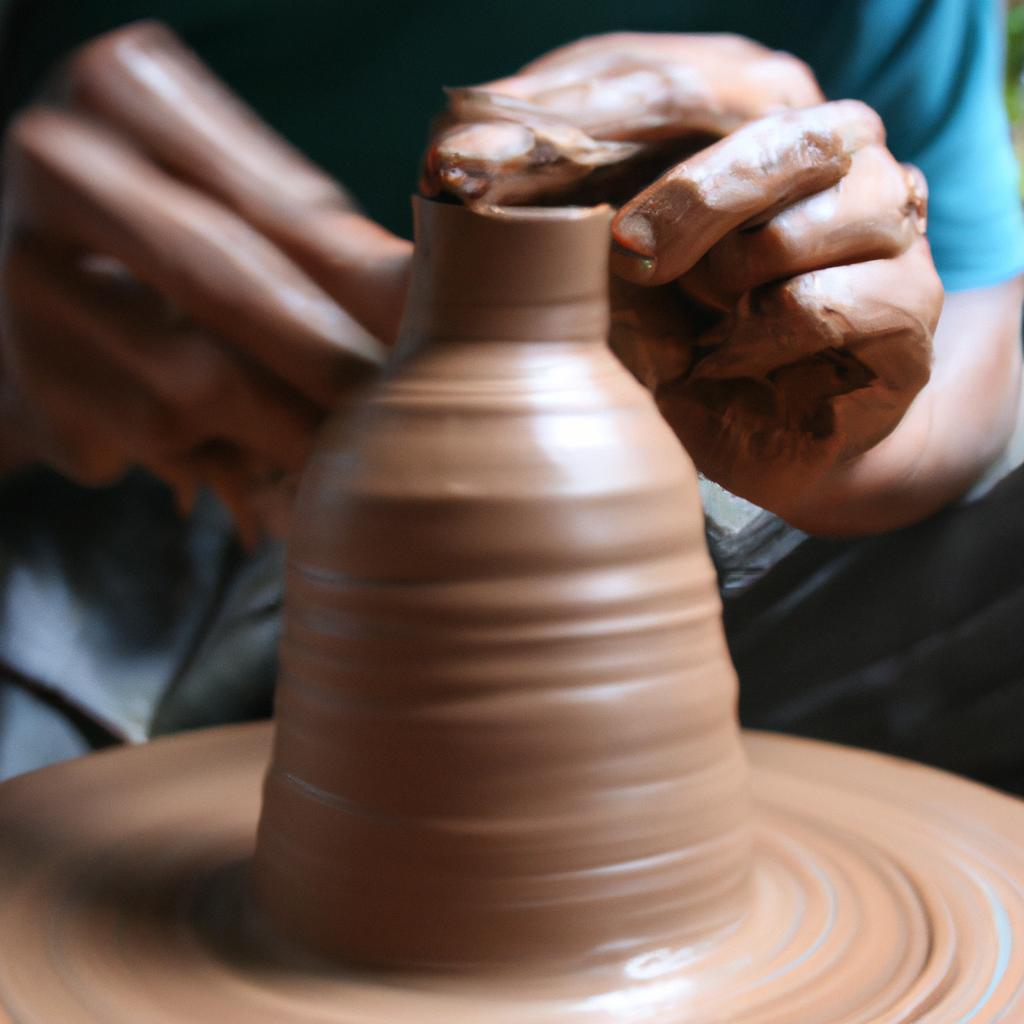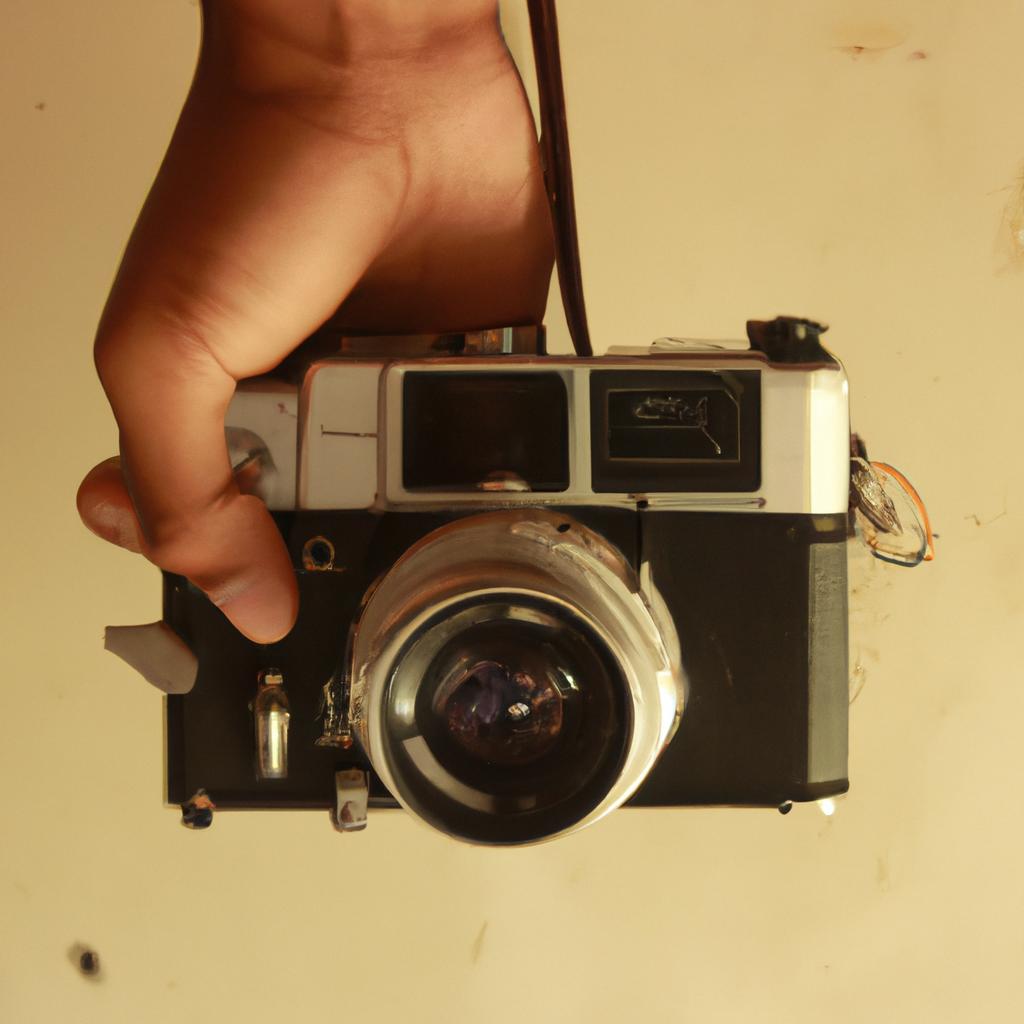Pottery Techniques: Ceramics in Visual Arts

Pottery techniques have long been a significant aspect of visual arts, bridging the gap between art and functionality. The intricate process of creating ceramics involves various methods that not only showcase artistic expression but also demonstrate remarkable technical skill. For instance, imagine an artist sculpting a vase using the coil technique, where long ropes of clay are carefully layered to form the desired shape. This ancient method has been utilized by countless civilizations throughout history, each adding their unique cultural touch to this timeless craft.
In addition to its historical significance, pottery techniques offer artists a versatile medium for self-expression and exploration of aesthetic concepts. By employing different hand-building techniques such as slab construction or pinching, artists can manipulate clay in ways that enable them to bring their creative visions to life. These processes allow for experimentation with texture, form, and surface decoration, resulting in visually captivating ceramic pieces that captivate viewers’ attention.
Moreover, mastering pottery techniques requires dedication and patience due to the demanding nature of working with clay. Artists must possess a deep understanding of material properties and firing processes to successfully execute their ideas. Through careful observation and practice, artisans continually refine their skills while developing new approaches that push the boundaries of what is possible within the realm of ceramics. Consequently, pottery techniques continue to evolve , leading to the emergence of innovative techniques and styles that reflect contemporary artistic trends and sensibilities. For example, artists may experiment with alternative firing methods like raku or saggar firing to achieve unique surface effects or explore new glazing techniques to create intricate patterns and colors on their ceramic pieces.
Additionally, pottery techniques offer a sense of connection to tradition and cultural heritage. Many communities around the world have deep-rooted pottery traditions that have been passed down through generations. By learning and practicing these time-honored techniques, artists not only contribute to the preservation of cultural knowledge but also infuse their work with a sense of history and authenticity.
Furthermore, pottery techniques can be adapted for various purposes beyond purely aesthetic considerations. Functional ceramics such as bowls, plates, and mugs are everyday objects that enhance our daily lives while showcasing the beauty of handmade craftsmanship. Additionally, pottery techniques can be applied in architectural ceramics, creating stunning tiles or sculptures that adorn public spaces and buildings.
In conclusion, pottery techniques hold immense value in the realm of visual arts. They provide artists with a versatile medium for self-expression, enable them to explore aesthetic concepts, connect them to cultural heritage, and produce functional objects that enrich our lives. The ever-evolving nature of these techniques ensures that pottery remains an exciting field for artistic innovation and creativity.
History of Pottery
Pottery, the art and craft of creating ceramic objects, has a rich history dating back thousands of years. One fascinating example of pottery’s historical significance is the discovery of ancient Egyptian pottery fragments. These remnants provide valuable insights into the lives and culture of this ancient civilization.
The history of pottery can be traced to various civilizations around the world, each contributing unique techniques and styles. In ancient China, for instance, potters developed high-fired stoneware known as porcelain, renowned for its exquisite translucency and delicate designs. Meanwhile, in Greece during the Classical period, red-figure pottery became popular, featuring intricate illustrations depicting mythological scenes.
- The tangible connection: Holding a piece of ancient pottery allows us to feel connected to our ancestors.
- Cultural preservation: Pottery serves as a time capsule that preserves traditions and cultural practices.
- Artistic expression: Each potter leaves their mark on clay through unique forms and decorative motifs.
- Continuity across generations: The passing down of pottery skills ensures that this ancient art form endures.
Moreover, let’s incorporate a table to further engage readers with visual cues:
| Civilization | Time Period | Notable Pottery Style |
|---|---|---|
| Ancient Egypt | 5th millennium BCE | Blue-glazed faience |
| Ancient China | 16th century BCE | Ming Dynasty celadon |
| Ancient Greece | 6th – 4th century BCE | Black-figure amphorae |
| Pre-Columbian America | AD 200 – AD 1500 | Moche stirrup-spout vessels |
In summary, the history of pottery is not solely about shaping clay; it encompasses human ingenuity, artistic expression, and cultural preservation. As we delve into the subsequent section on “Handbuilding Techniques,” we will explore how these historical foundations continue to influence contemporary pottery practices, demonstrating the enduring legacy of this ancient craft.
Handbuilding Techniques
From the rich history of pottery, we now delve into the fascinating realm of handbuilding techniques. By exploring various methods and approaches to shaping clay by hand, artists can create unique ceramic pieces that showcase their creativity and skill. To illustrate this further, let us consider a hypothetical case study involving a budding artist named Anna.
Anna, an aspiring ceramicist, begins her artistic journey by experimenting with different handbuilding techniques. She starts with pinch pottery, where she molds small bowls using her fingers and thumbs. This technique allows her to feel the clay’s texture intimately as she carefully shapes it into delicate forms. As Anna gains confidence in her skills, she moves on to coiling, constructing larger vessels by layering long coils of clay on top of one another. The repetitive nature of this method not only builds patience but also enables Anna to explore more intricate designs.
When it comes to slab construction, Anna discovers its versatility as she cuts flat sections of clay and joins them together to build functional objects like plates or boxes. This technique demands precision and attention to detail since any misalignment can compromise the overall structure of the piece. With each new project, Anna becomes aware of how these handbuilding techniques connect her tactile experiences with visual artistry.
As artists embrace handbuilding techniques in ceramics, they unlock endless possibilities for creative expression. Here are some key aspects that make these techniques invaluable:
- Intimacy with Clay: Handbuilding allows artists to directly engage with the material, feeling its malleability and responding intuitively.
- Versatility: Various methods such as pinching, coiling, and slab construction offer diverse ways to shape clay according to an artist’s vision.
- Exploration of Form: Through handbuilding techniques, artists have greater control over creating unique shapes and structures beyond what may be achieved through other means.
- Connection between Artistic Process and Final Outcome: Handbuilt ceramics often bear visible traces of the artist’s hands, conveying a sense of intimacy and authenticity.
To fully appreciate the diverse techniques involved in pottery, we will now explore another prominent method known as wheel throwing. This technique harnesses the rotational power of a potter’s wheel to shape clay into symmetrical forms with precision and fluidity. By understanding its intricacies, artists can further expand their repertoire of ceramic creations.
Wheel Throwing
From the foundational techniques of handbuilding explored in the previous section, we now delve into another fundamental method employed in pottery: wheel throwing. This technique involves shaping clay on a potter’s wheel to create symmetrical and intricate forms. To illustrate its potential, let us consider an example where a skilled ceramic artist skillfully uses wheel throwing to craft a delicately balanced porcelain vase adorned with intricate floral patterns.
Wheel throwing offers several advantages that contribute to its enduring popularity among artists and artisans alike. Firstly, it enables precision and symmetry in form creation due to the rotational motion provided by the potter’s wheel. The ability to effortlessly shape the clay while it spins allows for consistent thickness and elegant curves, resulting in visually appealing vessels or sculptures. Secondly, this technique facilitates efficient production as multiple pieces can be created simultaneously using molds or templates designed specifically for wheel-thrown objects. Lastly, through practice and experimentation, potters can develop their unique style within this technique—whether it is creating functional items like bowls or expressing artistic concepts through sculptural forms.
To better understand the various aspects associated with wheel throwing, here are some key considerations:
- Centering: Achieving proper centering of the clay on the wheel head lays the foundation for successful wheel throwing.
- Opening: Making an initial opening at the center of the clay helps establish its overall shape.
- Pulling: Gradually pulling up walls from the centered clay establishes height and desired vessel proportions.
- Trimming: Trimming excess clay from formed pieces ensures stability and refined finishing touches.
Additionally, exploring different types of clays, such as stoneware or porcelain, alongside glazing options further enhances creative possibilities when working with wheel-thrown ceramics.
| Considerations | Benefits |
|---|---|
| Precise symmetry | Aesthetically pleasing results |
| Efficient production | Increased productivity |
| Unique artistic expression | Creative exploration |
Incorporating wheel throwing into one’s pottery practice opens up a world of opportunities for creating functional and decorative ceramic pieces. By mastering the technique, potters can bring their artistic vision to life while also producing objects that serve practical purposes. With this understanding of wheel throwing, we transition seamlessly into the subsequent section on “Glazing and Firing,” where we explore how these final steps complete the transformative process of ceramics creation.
Glazing and Firing
Section H2: Glazing and Firing
Having gained an understanding of the wheel throwing process, we now delve into the crucial stage of glazing and firing in pottery techniques. Imagine a beautifully crafted vase taking shape on the potter’s wheel – its form meticulously sculpted and refined. The next step involves applying glaze to enhance both its aesthetic appeal and functionality.
Glazes are essentially glassy coatings that, when fired at high temperatures, transform into a durable surface layer. A wide range of glaze types exists, each yielding distinct results depending on their composition and application technique. For instance, a glossy transparent glaze can accentuate intricate details while adding a lustrous sheen to the piece. On the other hand, matte glazes lend a more subtle finish with their soft texture and muted appearance.
The firing process is where artistry meets science, as it involves subjecting the glazed ceramics to extreme heat in a kiln. This temperature-dependent transformation causes chemical reactions within the clay body and glaze, resulting in permanent changes to their physical properties. During firing, organic materials burn away completely from the clay matrix, leaving behind small voids known as “carbon coring.” These minute imperfections not only add character but also create interesting visual effects by influencing how light interacts with the surface.
To further explore the significance of glazing and firing in ceramics, consider these emotional responses:
- Anticipation: As artists prepare for firing their creations, there is an undeniable sense of excitement mixed with anticipation for what will emerge from the kiln.
- Satisfaction: Witnessing a well-executed combination of glaze colors meld together flawlessly under intense heat brings immense satisfaction to potters.
- Wonder: Discovering unexpected outcomes during firing – such as variations in color or unique crackling patterns – sparks wonderment among both creators and admirers.
- Nostalgia: Reflecting upon centuries-old traditions passed down through generations, glazing and firing evoke a sense of nostalgia for the rich history of ceramic artistry.
Furthermore, let us examine the following table that highlights various types of glazes:
| Glaze Type | Characteristics | Applications |
|---|---|---|
| Glossy | Shiny finish | Accentuates details |
| Matte | Soft texture, muted appearance | Provides a subtle finish |
| Crystalline | Crystal-like formations | Creates unique visual effects |
| Raku | Irregular surface patterns | Emphasizes organic aesthetics |
In summary, the glazing and firing stage is an essential part of pottery techniques. By skillfully applying different types of glazes and subjecting ceramics to high temperatures, artists bring their creations to life. This transformative process not only adds aesthetic beauty but also enhances functionality and durability. In our subsequent section on “Surface Decoration,” we will explore further avenues for artistic expression in ceramics beyond wheel throwing and glazing.
As we move forward to discuss “Surface Decoration” in more detail, let us now explore additional techniques that expand upon the foundation laid by wheel throwing and glazing.
Surface Decoration
Section H2: Surface Decoration
Having explored the glazing and firing techniques in pottery, we now turn our attention to surface decoration. A crucial aspect of ceramics in visual arts, surface decoration involves enhancing the aesthetic appeal of pottery through various artistic techniques. To illustrate this further, let us consider a hypothetical scenario where an artist employs intricate carving and painting methods to create a visually captivating ceramic vase.
Surface decoration offers artists a multitude of possibilities for creative expression. Through thoughtful application of decorative elements, they can transform plain ceramics into stunning works of art that captivate viewers’ imaginations. The following bullet point list showcases some popular surface decoration techniques utilized by artists:
- Sgraffito: This technique involves scratching or incising designs onto the clay’s surface before it is fired.
- Mishima: In this method, artists carve shallow lines on the clay’s surface and then fill them with contrasting colored slip before scraping away the excess.
- Majolica: Originating from Italy, majolica utilizes vibrant colors painted directly onto unfired glaze surfaces.
- Decalcomania: Artists apply pre-designed decals onto their pottery pieces before firing, allowing for intricate and detailed imagery.
To better understand how these techniques are applied in practice, consider the table below which demonstrates how different surface decorations contribute to distinct visual effects:
| Technique | Visual Effect |
|---|---|
| Sgraffito | Delicate line work |
| Mishima | Subtle texture |
| Majolica | Bold and vibrant |
| Decalcomania | Intricate patterns |
By skillfully employing these diverse techniques, potters can imbue their creations with a vast array of textures, patterns, and visual effects. Such mastery not only enhances the aesthetic value but also evokes emotional responses in both the creators and observers. With our understanding deepened regarding surface decoration practices in ceramics, we now transition to exploring the contemporary trends in pottery.
Continuing our exploration of ceramics in visual arts, we now delve into the realm of contemporary pottery trends.
Contemporary Pottery Trends
Section H2: Surface Decoration
In the previous section, we explored various techniques used in surface decoration to enhance the aesthetic appeal of ceramic artworks. Now, we will delve into contemporary pottery trends that have emerged in recent years, showcasing how these techniques are applied by artists to create unique and captivating pieces.
One fascinating example of a contemporary pottery trend is the fusion of traditional and modern design elements. As an illustration, let us consider the work of renowned artist Emma Thompson. Thompson seamlessly combines intricate hand-painted patterns inspired by ancient civilizations with sleek and minimalist forms. This juxtaposition creates a harmonious balance between tradition and innovation, resulting in visually striking ceramics that captivate viewers.
To further understand the impact of contemporary pottery trends on visual arts, let us explore some key characteristics that define this movement:
- Experimentation: Artists now push boundaries by experimenting with unconventional materials such as metals or glass shards embedded into clay surfaces.
- Narrative storytelling: Ceramic artworks increasingly incorporate narrative elements through illustrative motifs or sculptural features, inviting viewers to engage emotionally with the piece.
- Sustainability: Many artists prioritize sustainable practices by utilizing organic glazes or recycled materials, fostering an eco-conscious approach within the field.
- Cultural diversity: The globalization of art has led to a celebration of cultural diversity. Artists draw inspiration from different traditions worldwide, resulting in truly multicultural creations.
To provide a comprehensive overview of contemporary pottery trends and their associated concepts, consider the following table:
| Trend | Description | Example Artist |
|---|---|---|
| Nature-inspired | Emphasizes organic shapes and textures found in nature | Sarah Davis |
| Geometric abstraction | Utilizes geometric patterns and forms for bold and structured compositions | Michael Nguyen |
| Experimental techniques | Explores innovative methods like smoke firing or raku | Lisa Chen |
| Minimalistic | Focuses on simplicity and clean lines | David Park |
By embracing these contemporary pottery trends, artists create not only visually stunning artworks but also pieces that evoke a range of emotions and inspire meaningful connections with viewers. The fusion of traditional techniques with modern sensibilities allows for endless possibilities in the realm of ceramics, pushing boundaries and redefining what is possible within the visual arts.
Through this exploration of surface decoration and contemporary pottery trends, it becomes evident that ceramics continue to evolve as a dynamic medium, bridging past traditions with future innovation. As artists experiment, tell stories, prioritize sustainability, and embrace cultural diversity, their creations resonate deeply with audiences worldwide. This transformative journey within the world of ceramics showcases its enduring relevance in the ever-changing landscape of visual arts.

